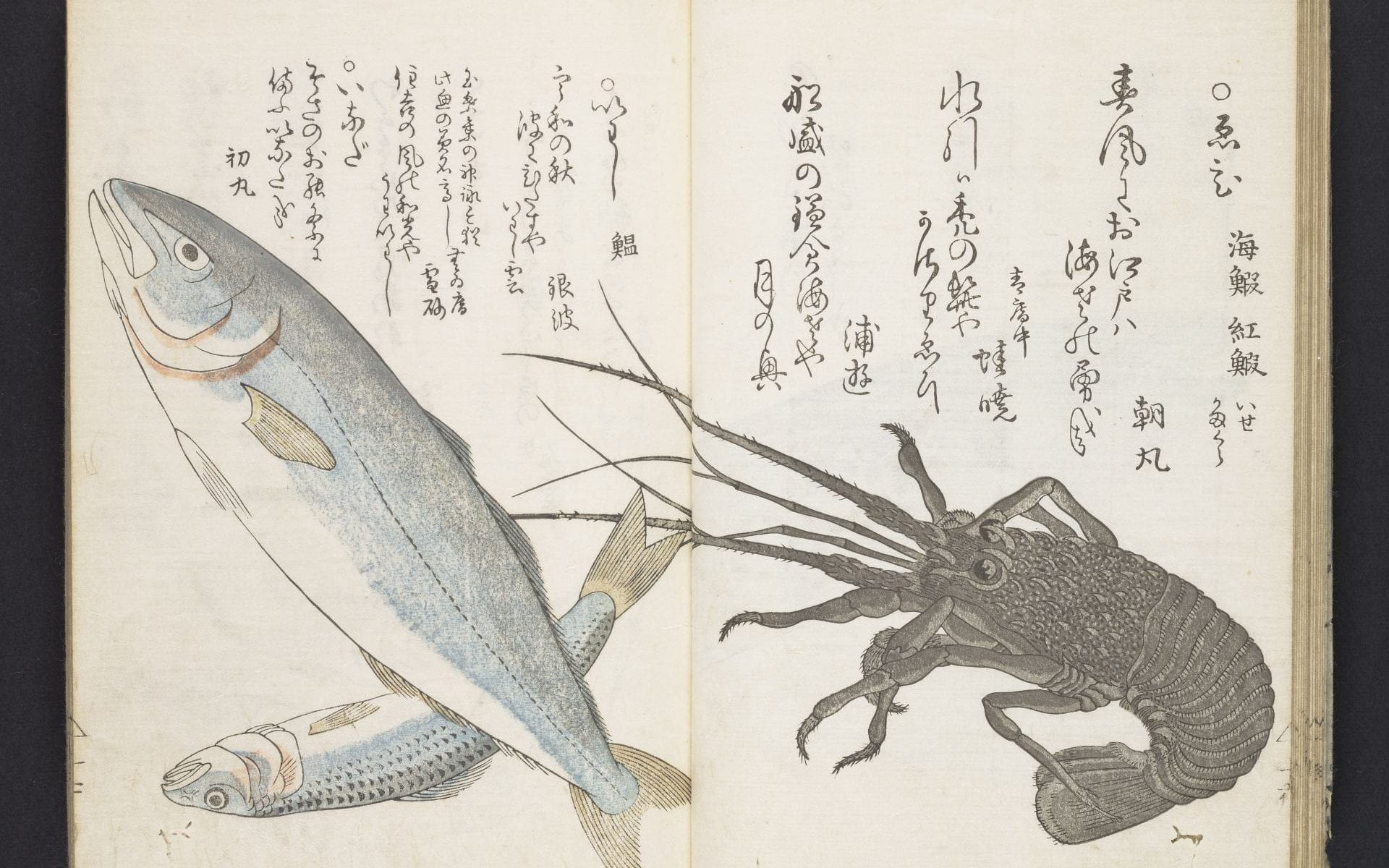Calligrapher: Hon’ami Kōetsu 本阿弥光悦 (1558-1637)
Original design: attributed to Tosa Mitsushige 土佐光重 (fl. 1390 – 1394)
Title: Sanjū rokkasen (三十六歌仙)
Date: c.1610
Medium: Black and white woodblock printed book; ink and color on paper
Dimension: H. 31.5cm x W. 22.8cm
Publisher: Gyokusendō, Kyoto
Gift of Arthur Tress. Box 76, Item 2.
https://franklin.library.upenn.edu/catalog/FRANKLIN_9977502831603681
The Sanjū rokkasen (“Thirty-Six Immortal Poets”) is a canonical list of prominent poets of the Asuka, Nara, and Heian Period compiled by Fujiwara no Kinto around the year 1010. These poets include famous names such as Kakinomoto no Hitomaro, Ono no Komachi, Ki no Tsurayuki, Ariwara no Narihira and so on. Kinto selected one exemplary poem from each of the poets and compiled the Sanjū rokkasen. Since then, this important collection has been often the source for Japanese literature and art.
The interest in creating imaginary portraits of the poets began in the late twelfth century. The thirty-six poets would be placed into two teams – the “left” team, consisting of the first eighteen poets, and the “right” team of the later eighteen poets. The portraits of the left team face the right, and the right teams face the left, as if they are looking at their opponents for a poetry competition (utaawase in Japanese). From the thirteenth century on, the format of this imaginary competition became the convention for the portrayal of Kinto’s “Thirty-Six Immortal Poets,” and it is also used in this example from the Tress Collection.
This variation on the Thirty-Six immortal poets was first published in 1610 as a commission by Suminokura Soan (1571-1632,) a wealthy merchant in Saga, a village close to Kyoto. Soan collaborated with Hon’ami Kōetsu, who contributed his fine calligraphy for the book. The original design of the illustration imitates paintings by Tosa Mitsushige from the fourteenth century. Each figure is depicted at different ages and with characteristic gestures that reflect their biographical information and anecdotes found in historical references.
The copy in the Tress Collection may be a private re-cut of the original print. Compared to other versions held in the British Museum, the Pulverer Collection, and the Harvard Collection, the Tress copy has some distinctive features that suggest it has been printed from a different set of blocks. Some notable evidence include that 1) the figures in the Tress copy overlap with the foreground decoration while the figures in the other collections are set further back in space; 2) the details in the Tress copy illustrations (e.g., patterns on the garments, hair and so on) differs slightly from that in the other collections; 3) there is a printed stamp of “玉泉堂藏刻 (literally means ‘Gyokusendō Storage Cut’)” on the last page of the Tress copy, which is not found in any other copies. The exact date of this copy is unknown, and the intention of this re-cut is yet to be assessed.
Below is a poem by Kakinomoto no Hitomaro (662-710) (page 1.)
Honobono to
Akashi no ura no
Asagiri ni
Shimagakureyuku
Fune o shi zo mou
Faintly with the dawn
That glimmers on Akashi Bay
In the morning mist
A boat goes hidden by the isle –
And my thoughts go after it4
Other copies of this book series:
Freer Gallery of Art, Washington DC
Harvard University, Arthur M. Sackler Museum
New York Public Library, New York City
The Gerhard Pulverer Collection
The British Museum
Selected Readings:
- Joshua S. Mostow, “A New “Classical” Theme: The One Hundred Poets from Elite to Popular Art in the Early Edo Period.” In Critical Perspectives on Classicism in Japanese Painting, 1600-1700 (2003). Elizabeth Lillehoj, 133-168.
- Nicole Fabricand-Person. “Cover Note.” The Princeton University Library Chronicle 73, no. 1 (2011): 165-69. Accessed February 19, 2020. jstor.org/stable/10.25290/prinunivlibrchro.73.1.0165.
- Jack Hillier, The Art of the Japanese Book, 2 vols. (London: Sotheby’s Publications by Philip Wilson Publishers Ltd., 1987), see esp. vol. 1, 47–50.
- Cranston, Edwin A. The Gem-Glistening Cup (1998). Vol. 1. Stanford University Press, 256.
- http://www.pulverer.si.edu/node/508/title/1
- https://www.harvardartmuseums.org/collections/object/210613
- https://asia.si.edu/exhibition/koetsu-sanjurokkasen-thirty-six-immortal-poets/
- https://research.britishmuseum.org/research/collection_online/collection_object_details.aspx?matcult=15712&objectId=779559&page=1&partId=1
Posted by Yuqi Zhao
February 19th, 2020

















